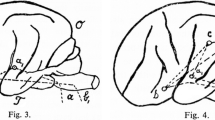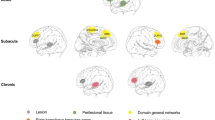Abstract
Despite a better understanding of the anatomy of the uncinate fasciculus (UF), its function remains poorly known. Our aim was to study the exact role of UF in language, and the possible existence of parallel distributed language networks within the “ventral stream”, underlaid by distinct subcortical tracts – namely the inferior occipito-temporal fasciculus (IOF) and UF.
We report a series of 13 patients operated on awake for a glioma involving the left anterior temporal lobe or the orbitofrontal area. We used intraoperative electrostimulation, to perform accurate and reliable anatomofunctional correlations both at cortical and subcortical levels. Using postoperative MRI, we correlated these functional findings with the anatomical locations of the sites where language disturbances were elicited by stimulation.
Intraoperative cortical stimulation found perilesional language sites in all cases. Subcortically, semantic paraphasia were induced in the 13 patients by stimulating the IOF, and phonological paraphasia were generated in 6 patients by stimulating the arcuate fasciculus. Interestingly, subcortical stimulation never elicited any language disturbances when performed at the level of the UF. Moreover, after a transient postoperative language deficit, all patients recovered, despite the removal of at least one part of the UF, as confirmed by control MRI.
We suggest that UF is not systematically essential for language. It can be explained by the fact that the “semantic ventral stream” might be constituted by at least two parallel pathways, i. e. a direct pathway underlaid by the IOF, crucial for language semantics, and an indirect pathway subserved by UF, which can be functionally compensated. However, we have to underline the fact not all language functions can be probed during surgery, and that more sensitive tasks have now to be added.
Similar content being viewed by others
References
Bell BD, Hermann BP, Woodard AR, Jones JE, Rutecki PA, Sheth R, Dow CC, Seidenberg M (2001) Object naming and semantic knowledge in temporal lobe epilepsy. Neuropsychology 15:434–443
Bello L, Gallucci M, Fava M, Carrabba G, Giussani C, Acerbi F, Baratta P, Songa V, Conte V, Branca V, Stocchetti N, Papagno C, Gaini SM (2007) Intraoperative subcortical language tract mapping guides surgical removal of gliomas involving speech areas. Neurosurgery 60:67–82
Bookheimer S (2002) Functional MRI of language: new approaches to understanding the cortical organizaton of semantic processing. Annu Rev Neurosci 25:151–188
Cappa SF, Frugoni M, Pasquali P (1998) Category-specific naming impairments for artefacts: a new case. Neurocase 4:391–397
Catani M, Howard RJ, Pajevic S, Jones DK (2002) Virtual in vivo interactive dissection of white matter fasciculi in the human brain. Neuroimage 17:77–94
Catani M, Jones DK, ffytche DH (2005) Perisylvian language networks of the human brain. Ann Neurol 57:8–16
Coppens JR, Mahaney KB, Abdulrauf SI (2005) An anteromedial approach to the temporal horn to avoid injury to the optic radiations fibers and uncinate fasciculus: anatomical and technical note. Neurosurg Focus 18:E3
Crosby EC, Humphery T, Lauer EW (1962) Correlative anatomy of the Nervous system. New York: MacMillan, 357:402–409
Déjerine J (1895) Anatomie des centres nerveux. Vol 1. Paris: Rueff et Cie, pp 532–577
Desmurget M, Bonnetblanc F, Duffau H (2007) Contrasting acute and slowgrowing lesions: a new door to brain plasticity. Brain 130:898–914
Devlin JT, Matthews PM, Rushworth MF (2003) Semantic processing in the left inferior prefrontal cortex: a combined functional magnetic resonance imaging and transcranial magnetic stimulation study. J Cogn Neurosci 15:71–84
Duffau H, Capelle L, Sichez N, Denvil D, Lopes M, Bitar A, Sichez JP, Fohanno D (2002) Intraoperative mapping of the subcortical language pathways using direct stimulations. An anatomofunctional study. Brain 125:199–214
Duffau H, Gatignol P, Denvil D, Lopes M, Capelle L (2003) The articulatory loop: study of the subcortical connectivity by electrostimulation. Neuroreport 14:2005–2008
Duffau H, Gatignol P, Mandonnet E, Peruzzi P, Tzourio-Mazoyer N, Capelle L (2005) New insights into the anatomo-functional connectivity of the semantic system: a study using cortico-subcortical electrostimulations. Brain 128:797–810
Duffau H (2005) Lessons from brain mapping in surgery for low-grade glioma: insights into associations between tumour and brain plasticity. Lancet Neurol 4:476–486
Duffau H, Thiebaut de Schotten M, Mandonnet E (2008) White matter functional connectivity as an additional landmark for dominant temporal lobectomy. J Neurol Neurosurg Psychiatry 79:492–495
Duffau H (2008) The anatomo-functional connectivity of language revisited. New insights provided by electrostimulation and tractography. Neuropsychologia 46:927–934
Duffau H, Gatignol P, Mandonnet E, Capelle L, Taillandier L (2008) Contribution of intraoperative subcortical stimulation mapping of language pathways: a consecutive series of 115 patients operated on for a WHO grade II glioma in the left dominant hemisphere. J Neurosurg 109:461–471
Ebeling U, von Cramon D (1992) Topography of the uncinate fascicle and adjacent temporal fiber tracts. Acta Neurochir (Wien) 115:143–148
Gaffan D, Easton A, Parker A (2002) Interaction of inferior temporal cortex with frontal cortex and basal forebrain: double dissociation in strategy implementation and associative learning. J Neurosci 22:7288–7296
Gaillard R, Naccache L, Pinel P, Clémenceau S, Volle E, Hasboun D, Dupont S, Baulac M, Dehaene S, Adam C, Cohen L (2006) Direct intracranial, FMRI, and lesion evidence for the causal role of left inferotemporal cortex in reading. Neuron 50:191–204
Gloor P (1997) The temporal lobe and the limbic system. New York: Oxford University Press
Glosser G, Salvucci AE, Chiaravalloti ND (2003) Naming and recognizing famous faces in temporal lobe epilepsy. Neurology 61:81–86
Goodglass H, Kaplan E (1972) The assessment of aphasia and related disorders. Philadelphia: Lea and Fibiger
Halgren E, Wang C, Schomer DL, Knake S, Marinkovic K, Wu J, Ulbert I (2006) Processing stages underlying word recognition in the anteroventral temporal lobe. Neuroimage 30:1401–1413
Hamberger MJ, Drake EB (2006) Cognitive functioning following epilepsy. Curr Neurol Neurosci Rep 6:319–326
Jefferies E, Lambon Ralph MA (2006) Semantic impairment in stroke aphasia versus semantic dementia: a caseseries comparison. Brain 129: 2132–2147
Kier EL, Staib LH, Davis LM, Bronen RA (2004) Anatomic dissection tractography: a new method for precise MR localization of white matter tracts. AJNR Am J Neuroradiol 25:670–676
Klinger J, Gloor P (1960) The connections of the amygdala and of the anterior temporal cortex in the human brain. J Comp Neurol 115:333–369
Lambon Ralph MA, McClelland JL, Patterson K, Galton JC, Hodges JR (2001) No right to speak? The relationship between object naming and semantic impairment: neuropsychological evidence and a computational model. J Cogn Neurosci 13:341–356
Lambon Ralph MA, Patterson K (2008) Generalization and differentiation in semantic memory: insights from semantic dementia. Ann N Y Acad Sci 1124:61–76
Lu LH, Crosson B, Nadeau SE, Heilman KM, Gonzalez-Rothi LJ, Raymer A, Gilmore RL, Bauer RM, Roper SN (2002) Category-specific naming deficits for objects and actions: semantic atribute and grammatical role hypotheses. Neuropsychologia 40:1608–1621
Makris N, Kennedy DN, McInerney S, Sorensen AG, Wang R, Caviness VS Jr, Pandya DN (2005) Segmentation of subcomponents within the superior longitudinal fascicle in humans: a quantitative, in vivo, DT-MRI study. Cereb Cortex 15:854–869
Mandonnet E, Nouet A, Gatignol P, Capelle L, Duffau H (2007) Does the left inferior longitudinal fasciculus play a role in language? A brain stimulation study. Brain 130:623–629
Mazoyer B, Dehaene S, Tzourio N (1993) The cortical representation of speech. J Cogn neurosci 5:467–479
Metz-Lutz M, Kremin H, Deloche G (1991) Standardisation d’un test de dénomination orale: contrôle des effets de l’âge, du sexe et du niveau de scolarité chez les sujets adultes normaux. Rev Neuropsychol 1:73–95
Nakamura M, McCarley RW, Kubicki M, Dickey CC, Niznikiewicz MA, Voglmaier MM, Seidman LJ, Maier SE, Westin CF, Kikinis R, Shenton ME (2005) Fronto-temporal disconnectivity in schizotypal personality disorder: a diffusion tensor imaging study. Biol Psychiatry 58:468–478
Ojemann G, Ojemann J, Lettich E, Berger M (1989) Cortical language localization in left, dominant hemisphere. An electrical stimulation mapping investigation in 117 patients. J Neurosurg 71:316–326
Oldfield RC (1971) The assessment and analysis of handedness: the Edinburgh inventory. Neuropsychologia 9:97–113
Parker GJ, Luzzi S, Alexander DC, Wheeler-Kingshott CA, Ciccarelli O, Lambon Ralph MA (2005) Lateralization of ventral and dorsal auditorylanguage pathways in the human brain. Neuroimage 24:656–666
Patterson K, Nestor PJ, Rogers TT (2007) Where do you know what you know? The representation of semantic knowledge in the human brain. Nat Rev Neurosci 8:976–987
Pobric G, Jefferies E, Ralph MA (2007) Anterior temporal lobes mediate semantic representation: mimicking semantic dementia by using rTMS in normal participants. Proc Natl Acad Sci USA 104:20137–20141
Price CJ, Devlin JT (2003) The myth of the visual word form area. Neuroimage 19:473–481
Rodrigo S, Oppenheim C, Chassoux F, Golestani N, Cointepas Y, Poupon C, Semah F, Mangin JF, Le Bihan D, Meder JF (2007) Uncinate fasciculus fiber tracking in mesial temporal lobe epilepsy. Initial findings. Eur Radiol 17:1663–1668
Scott SK, Blank CC, Rosen S, Wise RJ (2000) Identification of a pathway for intelligible speech in the left temporal lobe. Brain 123:2400–2406
Szeszko PR, Robinson DG, Ashtari M, Vogel J, Betensky J, Sevy S, Ardekani BA, Lencz T, Malhotra AK, McCormack J, Miller R, Lim KO, Gunduz-Bruce H, Kane JM, Bilder RM (2008) Clinical and neuropsychological correlates of white matter abnormalities in recent onset schizophrenia. Neuropsychopharmacology 33:976–984
Thompson-Schill SL, D’Esposito M, Aguirre GK, Farah MJ (1997) Role of left inferior prefrontal cortex in retrieval of semantic knowledge: a reevaluation. Proc Natl Acad Sci USA 94:14792–14797
Thompson-Schill SL, Aguirre GK, D’Esposito M, Farah MJ (1999) A neural basis for category and modality specificity of semantic knowledge. Neuropsychologia 37:671–676
Tippett LJ, Glosser G, Farah MJ (1996) A category-specific naming impairment after temporal lobectomy. Neuropsychologia 34:134–146
Vigneau M, Beaucousin V, Herve PY, Duffau H, Crivello F, Houdé O, Mazoyer B, Tzourio-Mazoyer N (2006) Meta-analyzing left hemisphere language areas: Phonology, semantics, and sentence processing. Neuroimage 30:1414–1432
Wise RJ (2003) Language systems in normal and aphasic human subjects: functional imaging studies and inferences from animal studies. Br Med Bull 65:95–119
Zahn R, Moll J, Krueger F, Huey ED, Garrido G, Grafman J (2007) Social concepts are represented in the superior anterior temporal cortex. Proc Natl Acad Sci USA 104:6430–6435
Author information
Authors and Affiliations
Corresponding author
Rights and permissions
About this article
Cite this article
Duffau, H., Gatignol, P., Moritz-Gasser, S. et al. Is the left uncinate fasciculus essential for language?. J Neurol 256, 382–389 (2009). https://doi.org/10.1007/s00415-009-0053-9
Received:
Revised:
Accepted:
Published:
Issue Date:
DOI: https://doi.org/10.1007/s00415-009-0053-9




